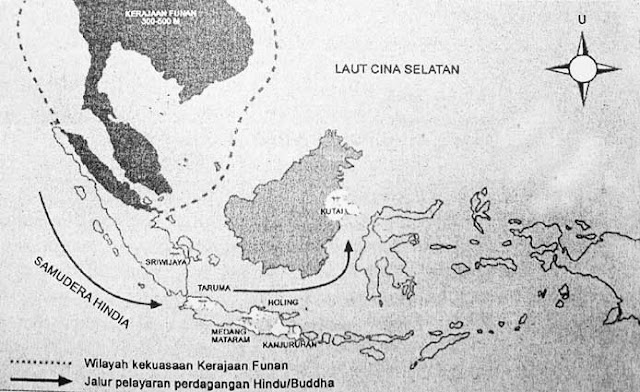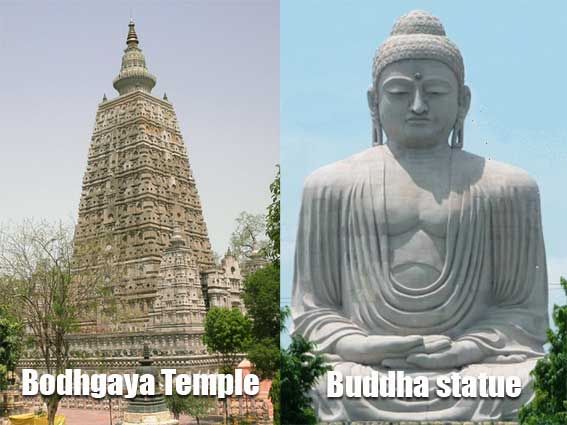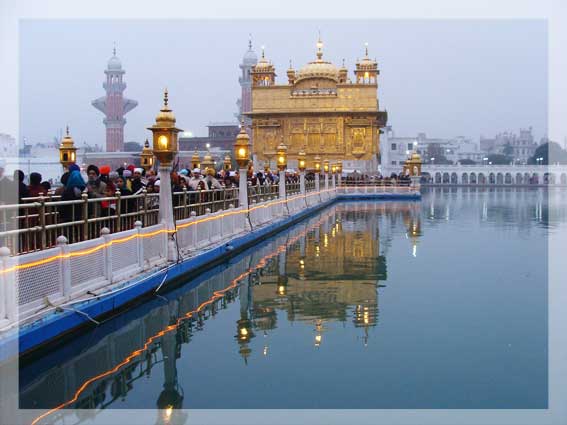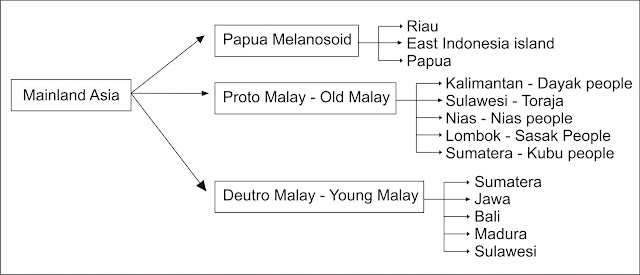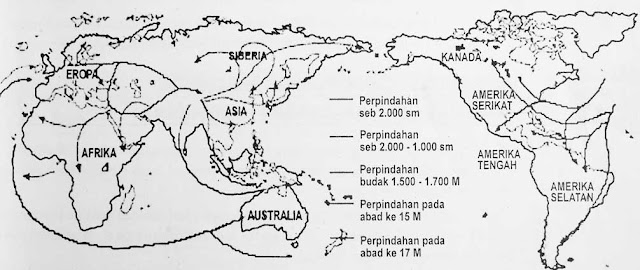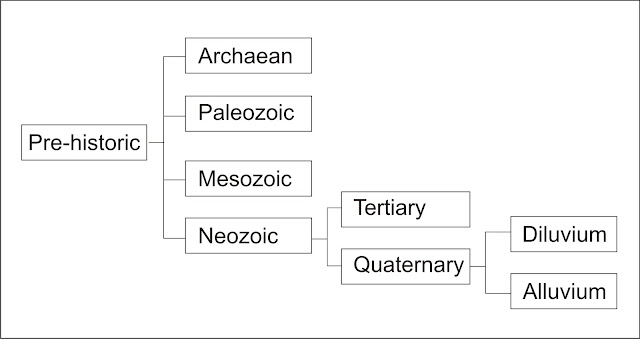Pembabakan zaman Pra-aksara berdasarkan peninggalan arkeologi - Zaman Pleistosen berakhir 10.000 tahun Sebelum Masehi, kemudian diikuti oleh datangnya zaman aluvium atau zaman holosin yang masih berlangsung hingga sekarang.
Dari zaman ini muncullah nenek moyang manusia sekarang, yaitu spesies homo sapiens atau makhluk cerdas. Zaman Pra aksara dapat dibagi berdasarkan pembagian menurut arkeologi (ilmu yang mempelajari hasil-hasil budaya pada masa lampau berupa benda-benda peninggalan dari kebudayaan manusia itu sendiri).
Atas dasar peninggalan itu zaman Pra aksara dapat dibagi menjadi sebagai berikut :
1. Pembabakan zaman Pra aksara berdasarkan peninggalan arkeologi
a. Zaman Batu
Zaman Batu terjadi sebelum logam dikenal dan alat-alat kebudayaan terutama dibuat dari batu di samping kayu dan tulang. Zaman batu ini dapat dibagi lagi menjadi 3, yaitu : zaman batu tua (Paleolithichum), Zaman batu tengah (Mesolithicum), dan zaman batu baru (Neolithicum). Pembahasan lebih jelasnya sebagai berikut :
1) Zaman batu tua (Paleolithichum)
Zaman batu tua disebut juga Paleolithichum. Mengapa disebut sebagai zaman batu tua? Sebab alat-alat batu buatan manusia masih dikerjakan secara kasar, tidak diasah atau dipoles. Alat-alat hidup tersebut bentuknya juga masih sangat sederhana. Contohnya : kapak genggam.
Apabila dilihat dari sudut mata pencahariannya, periode ini disebut masa berburu dan meramu makanan tingkat sederhana. Pendukung kebudayaan ini adalah homo erectus yang terdiri dari pithecanthropus dan homo erectus.
2) Zaman batu tengah (Mesolithicum)
Pada zaman batu tengah (Mesolithicum), alat-alat batu sebagian sudah dihaluskan, terutama bagian yang dipergunakan. Tembikar juga sudah dikenal pada masa itu. Periode ini juga disebut masa berburu dan meramu makanan tingkat lanjut.
Pendukung kebudayaan ini adalah homo sapiens (manusia sekarang), yaitu ras Austromelanosoide (mayoritas) dan Mongoloide (minoritas). Zaman ini merupakan masa peralihan di mana cara pembuatan alat-alat kehidupan lebih baik dan lebih halus dari zaman batu tua. Contohnya : pebble/kapak Sumatra.
3) Zaman batu baru (Neolithicum)
Alat-alat batu buatan manusia pada zaman batu baru (Neolithicum) sudah diasah atau dipoles sehingga lebih halus dan indah. Disamping itu, tembikar, tenun, dan batik juga sudah dikenal. Periode ini disebut masa bercocok tanam.
Pendukung kebudayaan ini adalah homo sapiens dengan ras Mongoloide (mayoritas) dan ras Austromelanosoide (minoritas). Contoh alat-alat zaman batu baru antara lain : apa persegi dan kapak lonjong.
Dari ketiga zaman batu tersebut ada pula para peneliti sejarah yang membagi zaman batu menjadi empat, silahkan baca di artikel prasejarah :
4 zaman batu
b. Zaman logam
Pada zaman logam, orang sudah dapat membuat alat-alat dari logam, disamping alat-alat dari batu. Orang sudah mengenal teknik melebur logam dan mencetaknya menjadi alat-alat yang diinginkannya.
Teknik pembuatan alat logam ada dua macam, yaitu dengan cetakan batu yang disebut
bivalve, dan dengan cetakan tanah liat dan lilin yang disebut
acire perdue. Selengkapnya tentang bivalve dan acire perdue silahkan baca di artikel :
Teknik cetakan Bivalve dan A Cire Perdue
Periode ini juga disebut masa perundagian. Mengapa disebut masa perundagian? Karena dalam masyarakat timbul golongan undagi yang terampil melakukan pekerjaan tangan.
Zaman logam ini masih dibagi lagi menjadi zaman tembaga, zaman perunggu, dan zaman besi. Pembahasan selengkapnya sebagai berikut:
1) Zaman tembaga
Orang menggunakan tembaga sebagai alat kebudayaan. Alat kebudayaan ini hanya dikenal di beberapa bagian dunia saja. Di Asia Tenggara (termasuk Indonesia), tidak dikenal zaman tembaga.
2) Zaman perunggu
Pada zaman perunggu orang sudah dapat mencampur tembaga dengan logam lain, sehingga diperoleh logam yang lebih keras. Karena hasil temuan yang dominan adalah alat-alat dari perunggu maka disebut zaman perunggu.
3) Zaman besi
Pada zaman besi orang sudah dapat melebur besi dari bijihnya untuk di tuang menjadi alat-alat yang diperlukan. Teknik peleburan besi lebih sulit dari teknik peleburan tembaga maupun perunggu, sebab melebur besi membutuhkan panas yang sangat tinggi, yaitu sekitar 3500 derajat celcius.
Zaman logam di Indonesia didominasi oleh alat-alat dari perunggu, sehingga zaman besi atau logam disebut juga zaman perunggu. Alat-alat besi yang ditemukan pada zaman logam jumlahnya sedikit dan bentuknya seperti alat-alat perunggu, sebab kebanyakan alat-alat dari besi ditemukan pada zaman sejarah.
Perlu ditegaskan, bahwa dengan dimulainya zaman logam bukan berarti berakhirnya zaman batu, karena pada zaman logam pun alat-alat dari batu terus berkembang, bahkan sampai sekarang. Sesungguhnya nama zaman logam hanyalah untuk menyatakan bahwa pada zaman tersebut alat-alat dari logam telah dikenal dan dipergunakan secara dominan.
Perkembangan zaman logam di Indonesia berbeda dengan di Eropa. Karena zaman logam di Eropa mengalami 3 fase/bagian, yaitu : zaman tembaga, zaman, perunggu, dan zaman besi. Sedangkan Indonesia khususnya dan Asia Tenggara umumnya tidak mengalami zaman tembaga, tetapi langsung memasuki zaman perunggu dan besi secara bersamaan.
Antara zaman batu dan zaman logam telah berkembang kebudayaan megalithicum, yaitu kebudayaan yang menggunakan media batu-batu besar sebagai alatnya. Bahkan puncak kebudayaan megalithicum justru pada zaman logam.
2. Pembabakan zaman Pra aksara berdasarkan Geologi
Berdasarkan geologi, zaman pra aksara di bagi menjadi 4, yaitu : zaman tertua (Arkaekum), zaman primer atau zaman hidup tua (Paleozoikum), Zaman sekunder atau zaman hidup pertengahan (Mesozoikum), dan Zaman hidup baru (Neozoikum). Pembahasan selengkapnya mengenai tiga zaman tersebut sebagai berikut:
a. Zaman tertua (Arkaekum)
Zaman tertua atau Arkaekum berlangsung kira-kira 2500 juta tahun, pada saat itu kulit bumi masih panas, sehingga tidak ada kehidupan. Dari penjelasan ini mungkin kit abertanya, lalu kapan muncul kehidupan?
c. Zaman primer atau zaman hidup tua (Paleozoikum)
Zaman primer atau Paleozoikum berlangsung selama 340 juta. Makhluk hidup yang muncul pada zaman ini seperti mikro organisme, ikan. amfibi, reptil, dan binatang ampfibi yang tidak bertulang punggung. Meskipun zaman primer berakhir, namun kehidupan terus berkembang, sehingga memasuki zaman baru.
c. Zaman sekunder atau zaman hidup pertengahan (Mesozoikum
Zaman sekunder atau Mesozoikum berlangsung kira-kira 140 juta tahun. Pada zaman pertengahan ini jenis reptil mencapai tingkat yang terbesar, sehingga zaman ini sering disebut juga dengan zaman reptil.
Setelah berakhirnya zaman sekunder ini, maka muncul kehidupan yang lain yaitu jenis burung dan bintang menyusui yang masih rendah sekali tingkatannya. Sedangkan jenis reptilnya mengalami kepunahan.
d. Zaman hidup baru (Neozoikum)
Zaman hidup baru atau Neozoikum dibedakan lagi menjadi dua, yaitu zaman ketiga (tersier) dan zaman keempat (kuartier), selengkapnya sebagai berikut :
1) Zaman ketiga (Tersier)
Zaman ketiga atau tersier berlangsung sekitar 60 juta tahun. Yang terpenting, pada zaman ini ditandai dengan berkembangnya jenisbinatang menyusui seperti jenis primata, misalnya kera.
2) Zaman keempat (Kuartier)
Zaman keempat atau kuartier ditandai dengan adanya kehidupan manusia sehingga merupakan zaman terpenting. Zaman kuartier dibagi lagi menjadi dua zaman, yaitu zaman Pleistosen dan Holosen.
Zaman Pleistose atau Dilluvum berlangsung rai600.000 tahun yang ditandai dengan adanya manusia purba. Sedangkan zaman Holosen atau Alluvium berlangsung kira-kira 20.000 tahun yang lalu dan terus berkembang sampai dewasa ini.Pada zaman ini ditandai dengan munculnya manusia jenis homo sapiens yang memiliki ciri-ciri seperti manusia sekarang ini.
3. Pembabakan zaman Pra aksara berdasarkan ciri-ciri kehidupan masyarakat
Makhluk manusia adalah makhluk yang hidup berkelompok dan mempunyai organisme yang secara biologis berbeda dan lebih lemah dari jenis binatang. Namun, otak manusia berevolusi paling jauh bila dibandingkan dengan makhluk lainnya.
Kemampuan otak manusia yang berupa proses berpikir menyebabkan manusia dapat memilah-milah tindakan yang dapat menguntungkan kelangsungan hidupnya.
Dalam rangka kelangsungan hidupnya maka manusia merupakan makhluk pembentuk kebudayaan dan manusia juga sebagai pembentuk masyarakat, karena pada hakekatnya manusia tidak dapat hidup sendiri tetapi harus berkelompok.
Kehidupan masyarakat (manusia) pada zaman pra aksara terbagi menjadi 3 periode, yaitu sebagai berikut :
a. Masa berburu dan mengumpulkan makanan
Pada masa berburu dan mengumpulkan makanan, secara fisik manusia masih terbatas usahanya dalam menghadapi kondisi alam. Tingkat berpikir manusia yang masih rendah menyebabkan hidupnya berpindah-pindah tempat dan bergantung kepada alam dengan cara berburu dan mengumpulkan makanan.
b. Masa bercocok tanam
Pada masa bercocok tanam, kemampuan manusia mulai berkembang, sehingga timbul upaya menyiapkan persediaan bahan makanan yang cukup dalam suatu masa tertentu. Dalam upaya tersebut, maka manusia bercocok tanam dan tidak lagi tergantung kepada alam.
c. Masa perundagian
Pada masa perundagian asyraat sudahmengenal teknik-teknik pengolahan logam. Pengolahan logam memerlukan keahlian khusus. Pekerjaan mengolah logam untuk membuat benda-benda tertentu disebut perundagian, sedangkan orang yang ahli mengerjakannya dikenal dengan sebutan undagi.
Demikian uraian Pembabakan zaman Pra aksara yang cukup panjang, semoga memberikan manfaat bagi kita semua untuk lebih mengenal masa prasejarah.
